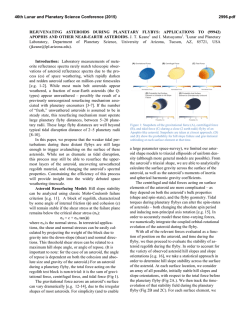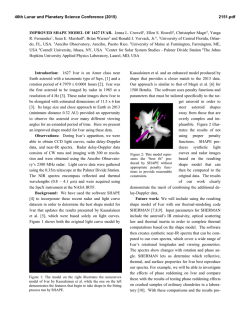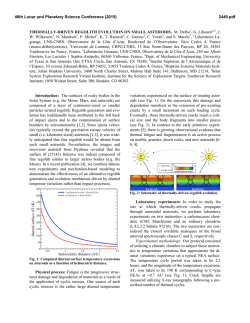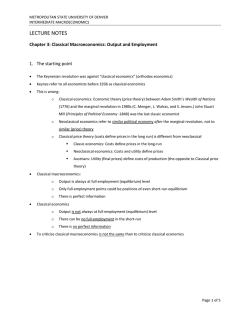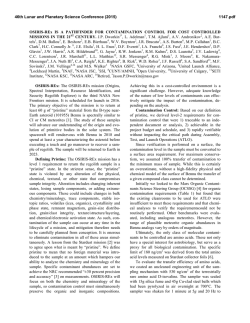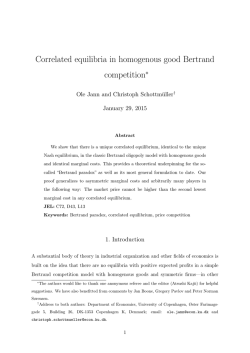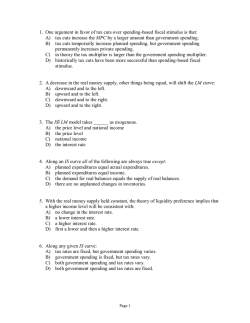
Bifurcation of Equilibrium Points in the Potential Field of Asteroid
46th Lunar and Planetary Science Conference (2015) 1878.pdf BIFURCATION OF EQUILIBRIUM POINTS IN THE POTENTIAL FIELD OF ASTEROID 101955 BENNU. X. Wang1, J. Li2 and S. Gong2, 1Ph.D. candidate, School of Aerospace Engineering, Tsinghua University, Beijing, China, [email protected], 2Professor, School of Aerospace Engineering, Tsinghua University, Beijing, China, [email protected], 3Associate professor, School of Aerospace Engineering, Tsinghua University, Beijing, China, [email protected]. Introduction: Asteroids and comets are thought to be critical as the key to understand the origin and evolution of the solar system and have attracted many researchers to focus on this topic. In this paper, the stability and topological structure of equilibrium points in the potential field of asteroid 101955 Bennu have been investigated with varied density and rotation period, which show fruitful results of the dynamical system of a noncentral rotating potential field. The polyhedral method performed by Werner and Scheeres(1996) is used to investigate the gravitational field of asteroid Bennu. In order to have a global view of the dynamic system of the minor bodies, both the internal and external potential fields are investigated. Most of the minor bodies such as asteroids and comets are irregular-shaped along with a rapid rotation period, which makes the orbital dynamic in the vicinity of them highly nonlinear and quite different from that of planets. Though there are some small bodies missions have been performed, the dynamic environment near an asteroid or a comet is still filled with unknown and very complex. In Hayabusa mission, the spacecraft carried a detachable minilander, MINERVA, but it failed to reach the surface of Itokawa due to the complex dynamical environment. So further investigation must be performed for both science issuses and future missions to small bodies. The polyhedral model of The three-dimensional shape model of asteroid Bennu adopted in this paper was driven from the radar images and optical lightcurves by Nolan et al.(2013). The asteroid is quite irregular-shaped and has no any symmetry with a wrinkle-pop shape. Figure 1 shows the polyhedral model with 1348 vertices and 2692 faces, which provides the geometric dimensions of Bennu to be 576×539 × 526 m with a mean diameter of 492 ± 20 m. The volume is also calculated as 0.0623 ± 0.006 km3. Considering the gravitational dynamics and Yarkovsky effect, the bulk density is estimated as 1260 ± 70 kg/m3, thus associated with a mass of (7.8 ± 0.9) × 1010 kg. This has indicated a macroporosity in the range of 40 ± 10%, suggesting a rubble-pile internal structure of Bennu. Using radar images and optical lightcurves, the rotation period of Bennu is derived as 4.29746 ± 0.002 h, which is a rather fast spin speed and supposed still being spun up. Figure 1. Polyhedral Model of Asteroid Bennu. Considering the spacecraft as a massless particle orbiting the rotating Bennu, the equations of motion, which are time-varying in the inertial reference frame, can be easily written as autonomous differential equations in the body-fixed frame as follows: r 2 r r U (r ) , (1) where r is the body-fixed vector from the original point to the field point, ω is the angular velocity of the asteroid Bennu. When applying the principal-axis rotation, ω is a constant with the magnitude |ω|=ω. U(r) is the gravitational potential, which is time-invariant and only related to the position of the field point. The value of U(r) is performed by using the polyhedral method. In order to get a more general result of orbital dynamics near an asteroid, nondimensionalization was introduced. The equivalent radius r0 of Bennu is the characteristic unit to scale the length, which is defined as follow: 46th Lunar and Planetary Science Conference (2015) L r0 3 3Volume / 4 245.88 m , and the characteristic unit of time is T 1/ 2462.26 s . (2) (3) 1878.pdf There are many other conditions when applying this method to other irregular-shaped bodies and fruitful bifurcation occurs. So the nondimensionalized form of dynamical equations can be obtained as (4) r 2 r ( r ) U (r ) , where the gravitational attraction term U ( r ) also changes the form correspondingly as U ( r ) ( eedges Ee re Le f faces Ff rf f ) , (5) with a dimensionless quantity η as follow: G 2 . (a) η= 0.30 (b) η= 0.55 (c) η= 0.57 (d) η= 0.65 (6) The equilibrium points and their stabilities are studied. Except the polyhedral shape model, the dynamical equations in the vicinity of irregular-shaped small bodies are relevant to the physical properties of the small bodies, such as density and rotation period, which are all involved in the dimensionless quantity η for the dimensionless form. These physical properties are not very accurate and different results show differences. Hirabayashi and Scheeres (2014) have used these differences to study the structural constrains of 216 Kleopatra with the size as a variable parameter. On the other hand, because of the Yarkovsky effect, the rotation period of some small bodies has become shorter with the example of asteroid 54509 YORP (2000 PH5). On the year of 2005, it rotated another 250 degrees more than that was expected in 2001, whose spin velocity is still rising every day. So in this paper, the number and stability of equilibrium points are investigated with variable physical properties. Fruitful results of the orbital dynamics in the vicinity of an asteroid are performed, which indicates bifurcation for not only the number of the equilibrium points but also topological structure of the manifold near the equilibrium points. Figure 2 shows the bifurcation of the number of equilibrium points of asteroid 101955 Bennu. The number and position of equilibrium points of asteroid 101955 Bennu have both changed if the rotation period has varied. With the dimensionless quantity η of the asteroid increasing, the two equilibrium points on the bottom right of Figure 2(a) mix up and disappeared as showed in Figure 2(d). The same situation will occurs for the two equilibrium points on the upper left of Figure 2(a) if η continues to increase as showed in Figure 2(f). Also the topological structure of the equilibrium points will change which indicates bifurcation. An equilibrium point can change from an unstable saddle point to a stable center point, which indicates that there will be new period orbits near the equilibrium point. (e) η= 0.70 (f) η= 1.00 Figure 2. The Equilibrium Points and Zero Velocity Curves of Bennu with the Variation of η. The results of this research can help to make a better understanding of the dynamic environment near a small body with the consideration of the inaccuracy of the physical properties. It provides physical examples with the background in astrodynamics to show the phenomena of bifurcation in the potential field, which is very interesting in math and physics. References: [1] Werner R. A. and Scheeres D. J. (1996) Celestial Mechanics & Dynamical Astronomy, 65, 313–344. [2] Nolan M. C. et al. (2013) Icarus, 226, 629–640. [3] Carry B. (2012) Planet. & Space Sci., 73, 98–118. [4] Hirabayashi M. and Scheeres D. J. (2014) Astrophys. J., 780, 160–170. [5] Taylor P. A. et al. (2007) Science, 316, 274–277.
© Copyright 2025

